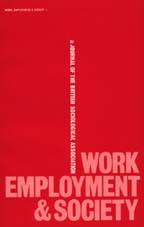Crossref Citations
This article has been cited by the following publications. This list is generated based on data provided by
Crossref.
Tremblay, Diane‐Gabrielle
2002.
Balancing work and family with telework? Organizational issues and challenges for women and managers.
Women in Management Review,
Vol. 17,
Issue. 3/4,
p.
157.
Felstead, Alan
Jewson, Nick
Phizacklea, Annie
and
Walters, Sally
2002.
Opportunities to work at home in the context of work‐life balance.
Human Resource Management Journal,
Vol. 12,
Issue. 1,
p.
54.
Nolan, Peter
2003.
Reconnecting with History: The ESRC Future of Work Programme.
Work, Employment and Society,
Vol. 17,
Issue. 3,
p.
473.
Felstead, Alan
Jewson, Nick
and
Walters, Sally
2003.
Managerial Control of Employees Working at Home.
British Journal of Industrial Relations,
Vol. 41,
Issue. 2,
p.
241.
Tietze, Susanne
and
Musson, Gill
2003.
The times and temporalities of home‐based telework.
Personnel Review,
Vol. 32,
Issue. 4,
p.
438.
MUSSON *, GILL
and
TIETZE †, SUSANNE
2004.
Feelin' groovy♪: appropriating time in home‐based telework.
Culture and Organization,
Vol. 10,
Issue. 3,
p.
251.
Tietze, Susanne
2005.
Discourse as strategic coping resource: managing the interface between “home” and “work”.
Journal of Organizational Change Management,
Vol. 18,
Issue. 1,
p.
48.
Tietze, Susanne
and
Musson, Gill
2005.
Recasting the Home-Work Relationship: A Case of Mutual Adjustment?.
Organization Studies,
Vol. 26,
Issue. 9,
p.
1331.
Felstead, Alan
Jewson, Nick
and
Walters, Sally
2005.
The shifting locations of work.
Work, Employment and Society,
Vol. 19,
Issue. 2,
p.
415.
Tipple, Graham
2006.
Employment and work conditions in home-based enterprises in four developing countries: do they constitute ‘decent work’?.
Work, Employment and Society,
Vol. 20,
Issue. 1,
p.
167.
Foley, Simon
2007.
Human Interface and the Management of Information. Interacting in Information Environments.
Vol. 4558,
Issue. ,
p.
863.
Louie, Amber M.
Ostry, Aleck S.
Quinlan, Michael
Keegel, Tessa
Shoveller, Jean
and
LaMontagne, Anthony D.
2007.
Empirical Study of Employment Arrangements and Precariousness in Australia.
Relations industrielles,
Vol. 61,
Issue. 3,
p.
465.
Hislop, Donald
and
Axtell, Carolyn
2007.
The neglect of spatial mobility in contemporary studies of work: the case of telework.
New Technology, Work and Employment,
Vol. 22,
Issue. 1,
p.
34.
Griffiths, Sam
Vaughan, Laura
Haklay, Mordechai (Muki)
and
Emma Jones, Catherine
2008.
The Sustainable Suburban High Street: A Review of Themes and Approaches.
Geography Compass,
Vol. 2,
Issue. 4,
p.
1155.
Di Domenico, MariaLaura
2008.
‘I'm Not Just a Housewife’: Gendered Roles and Identities in the Home‐Based Hospitality Enterprise.
Gender, Work & Organization,
Vol. 15,
Issue. 4,
p.
313.
Chalmers, Lee
2008.
Using IT in work at home: taking a closer look at IT use in home‐located production.
New Technology, Work and Employment,
Vol. 23,
Issue. 1-2,
p.
77.
Redman, Tom
Snape, Ed
and
Ashurst, Colin
2009.
Location, Location, Location: Does Place of Work Really Matter?.
British Journal of Management,
Vol. 20,
Issue. s1,
Tietze, Susanne
Musson, Gill
and
Scurry, Tracy
2009.
Homebased work: a review of research into themes, directions and implications.
Personnel Review,
Vol. 38,
Issue. 6,
p.
585.
Wight, Vanessa R.
and
Raley, Sara B.
2009.
When Home Becomes Work: Work and Family Time among Workers at Home.
Social Indicators Research,
Vol. 93,
Issue. 1,
p.
197.
Nätti, Jouko
Tammelin, Mia
Anttila, Timo
and
Ojala, Satu
2011.
Work at home and time use in Finland.
New Technology, Work and Employment,
Vol. 26,
Issue. 1,
p.
68.


